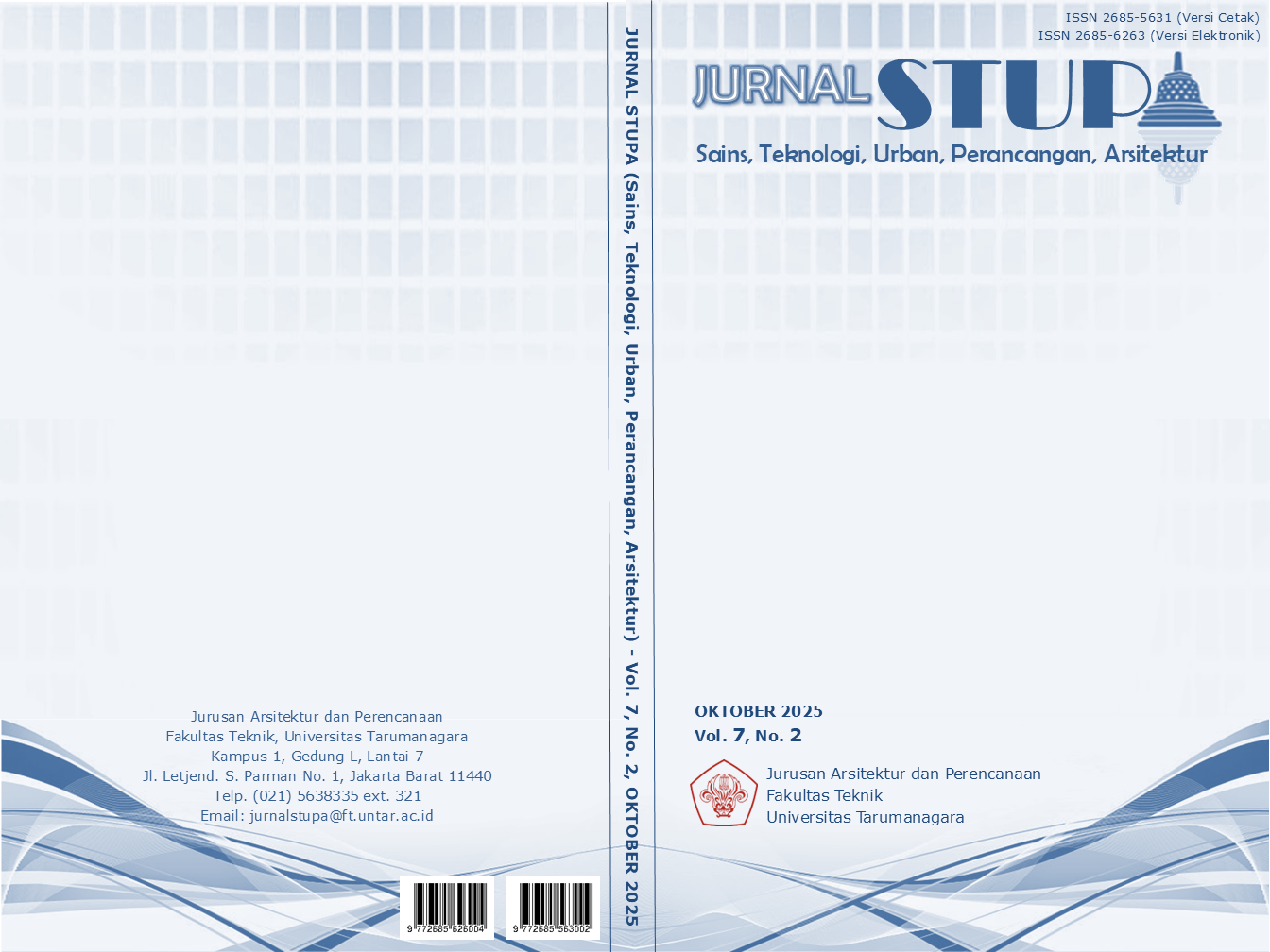SISTEM AQUACULTURE DAN LUNAR HARVESTING SEBAGAI PENERAPAN ARSITEKTUR REGENERATIF PADA PERANCANGAN WISATA KAMPUNG NELAYAN CILINCING
Main Article Content
Abstract
Kampung Nelayan Cilincing experiences significant ecological pressure due to the accumulation of plastic waste from urban activities on the coast of North Jakarta. This plastic waste ends up in the ocean and produces microplastics, plastic particles measuring less than 5mm that endanger the marine ecosystem, food chain, and human health. This study aims to optimize Kampung Nelayan Cilincing with the concept of "regenerative architecture" through tourism design that can have a positive impact on the surrounding environment (especially in terms of ecology). The systems used include aquaculture and lunar harvesting systems. Literature reviews show that aquaculture and lunar harvesting play a role in reducing microplastics and empowering coastal communities through healthy and varied marine cultivation. The tourism design is motivated by the history of nature-based tourism in Kampung Nelayan Cilincing known as Cilincing Palm Beach. The research method is carried out qualitatively and quantitatively. Referring to the book "Notes on the Synthesis of Form" by Christopher Alexander, this study maps the variables of aquaculture, lunar harvesting, and site variables (physical, community, tourism) and analyzes the connections between variables to obtain a synthesis of form. The results of the synthesis research form that the aquaculture variable is physically close to the open sea and swamps, is socially compatible, and can be packaged as tourism. Meanwhile, the lunar harvesting variable is physically close to only the open sea and has similar physical and tourism results. Both of these systems, aquaculture and lunar harvesting are effective in implementing regenerative architecture in the design of the Kampung Nelayan Cilincing tourism.
Keywords: aquaculture; Cilincing Fisherman Village; lunar harvesting; microplastic
Abstrak
Kampung Nelayan Cilincing mengalami tekanan ekologis yang signifikan akibat akumulasi sampah plastik dari aktivitas urban di pesisir Jakarta Utara. Sampah plastik ini bermuara ke lautan dan menghasilkan mikroplastik, sebuah partikel plastik berukuran kurang dari 5mm yang membahayakan ekosistem laut, rantai makanan, dan kesehatan manusia. Penelitian ini bertujuan untuk mengoptimalisasi Kampung Nelayan Cilincing dengan konsep “regenerative architecture” melalui perancangan wisata yang dapat memberikan dampak positif bagi lingkungan di sekitarnya (khususnya dari segi ekologis). Sistem yang digunakan mencakup sistem aquaculture dan lunar harvesting. Kajian literatur menunjukkan bahwa aquaculture dan lunar harvesting berperan dalam mengurangi mikroplastik dan memberdayakan masyarakat pesisir melalui budidaya laut yang sehat dan variatif. Perancangan wisata dilatarbelakangi oleh histori wisata berbasis alam Kampung Nelayan Cilincing yang dikenal sebagai Cilincing Palm Beach. Metode penelitian dilakukan secara kualitatif dan kuantitatif. Dengan mengacu pada buku “Notes on the Synthesis of Form” karya Christopher Alexander, penelitian ini memetakan variabel aquaculture, lunar harvesting, dan variabel tapak (fisik, masyarakat, wisata) dan melakukan analisis koneksi antar variabel untuk mendapatkan sintesis bentuk. Hasil penelitian sintesis bentuk bahwa variabel aquaculture secara fisik memiliki kedekatan dengan laut lepas dan rawa, secara masyarakat kompatibel, dan dapat dikemas secara wisata. Sementara itu, variabel lunar harvesting secara fisik memiliki kedekatan dengan hanya laut lepas, dan memiliki koneksi masyarakat dan wisata yang serupa. Kedua sistem ini, aquaculture dan lunar harvesting efektif menjadi penerapan arsitektur regeneratif pada perancangan wisata Kampung Nelayan Cilincing.
Article Details

This work is licensed under a Creative Commons Attribution-NonCommercial-ShareAlike 4.0 International License.
This work is licensed under a Jurnal Sains, Teknologi, Urban, Perancangan, Arsitektur/ STUPA Creative Commons Attribution-NonCommercial-ShareAlike 4.0 International LicenseReferences
Alexander, C. (1973). Notes on the Synthesis of Form. London: Seventh Printing.
Altmayer, A. (2024). EU aquaculture: State of play. EPRS | European Parliamentary Research Servic, 1-12.
Armstrong, R. (2023). Introducing Regenerative Architecture. Journal of Chinese Architecture and Urbanism , 1-11.
Gerakan Indonesia Diet Kantong Plastik (GIDKP). (2023). Screening Awal Mikroplastik di Perairan Provinsi DKI Jakarta. Jakarta.
Mayoral, O., Domenech, J. C., Solbes, J., & Pina, T. (2020). What Has Been Thought and Taught on the Lunar Influence on Plants in Agriculture? Perspective from Physics and Biology. Agronomy, 1-23. doi:10.3390
Miodonski, I. (2023). Regenerative Architecture: The inspiration towards greater sustainability. 1-75.
Troell, M., Beveridge, M., Kautsky, N., & Henriksson, P. J. (2017). Aquaculture. Elsevier Reference Module in Life Sciences, 1-16.
United Nations. (2024). The State of World Fisheries and Aquaculture. The State of World, 2-264.
Yaqin, K., Nabil Al Ashad, A., Efansyah, A. M., Malkab, A. N., & Yusran, M. (2023). Taman Epibion untuk Bioremediasi Mikroplastik secara In Situ di Perairan Makassar. Jurnal Pengelolaan Perairan, 5(1-11), 1-11.



